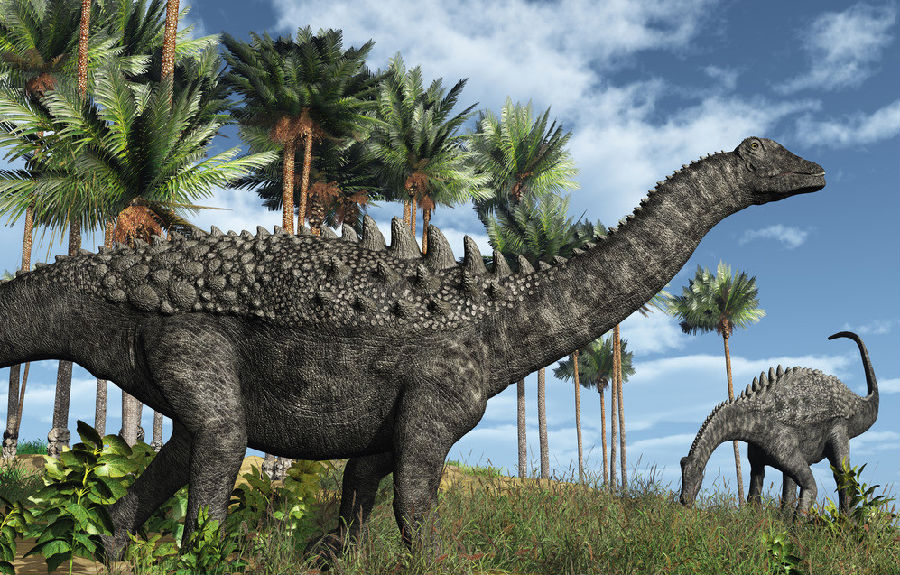All around the world, birds, like dinosaurs, fill just about every habitat in every environment, from the rainforest to the mountains to the seacoast.
全世界范圍內,如同恐龍一樣,鳥類居住在各式各樣的環境當中,從雨林到山地,再到海岸。
An ostrich, nearly 3 meters tall and over 135 kilos, is the largest modern bird.
鴕鳥,幾乎高達三米,重達一百三十五公斤是現今最大的鳥類。
That may pale in comparison to a Tyrannosaurus rex or the giant Sauroposeidon.
這與霸王龍或者巨型的波塞東龍相比可能蒼白無力。
But the biodesigns which give birds their ability to get up in the air, to maneuver in flight, and to reproduce are clearly found in dinosaurs...genetic traits that once allowed dinosaurs to grow to mammoth proportions or survive in a world of brutal killers.
但是使鳥類能夠飛行翱翔的身體設計以及繁殖方式都有恐龍的影子,這些遺傳性狀曾經一度幫助恐龍長成龐然大物或在殺手林立的世界里生存。
Features honed by 165 million years of evolution simply never went away.
這些經過一億六千五百萬年進化洗禮的特征不會輕易消失。
Tools that once served dinosaurs so well have adapted to serve new functions in modern birds.
那些曾經服務于恐龍的工具繼續為現代鳥類服務。

Dinosaurs used hollow bones to grow very large. Birds use them to save weight.
恐龍利用中空的骨骼成長。鳥類用它減輕重量。
Dinosaurs used air sacs to move air along their massive necks. Birds use air sacs to stay aloft for long periods.
恐龍利用氣囊使空氣在龐大的頸部流動。鳥類利用氣囊保持長期高空飛行。
So in many ways the only difference between dinosaurs and birds is scale.
所以從很多方面講恐龍和鳥類的唯一區別就在于體積。
And there's even evidence that many terrestrial dinosaurs nearly had what it takes to fly.
甚至有證據表明很多陸生恐龍幾乎具備飛行的條件。
In fact, the arms and hands of Deinonychus worked remarkably like a bird's wings.
事實上,恐爪龍的前臂和爪子與鳥類的翅膀非常相似。
For Deinonychus, this high-speed motion creates a grasping claw able to dig deep into flesh.
對于恐爪龍,高速運動造就了深深刺入血肉的利爪。
In a bird, this same feature allows its wings to flap at those same high speeds...the key to flight.
而對于鳥類,同樣的因素使翅膀能夠告訴拍打,這是飛行的關鍵。
Deinonychus' arms were very specialized, much like modern birds.
恐爪龍的前臂非常專一化,酷似現代鳥類。
In fact, like a modern bird, they have the ability to fold their arms, or their wings, if you will, to the side.
事實上,如同現代鳥類,它們有能力將前臂或者說兩翼彎曲到一側。
This is the same folding ability that allows birds to fly today.
這與今天鳥類飛行的折翅能力如出一轍。
The wings of a bird in flight are a living example of Deinonychus' claw in action. Look at a bird out in nature.
鳥類飛行時的翅膀就是恐爪龍利爪運動時的翻版。看看自然界的鳥類。
As it's moving its wings back and forth, the pattern of the joints and the angle of the joints in the wings of birds closely match the pattern we see in Deinonychus.
隨著它們來回拍打翅膀,其關節模式以及兩翼關節的角度與恐爪龍的十分吻合。
And there's one final clue... A clue that all but definitively connects birds and dinosaurs, and it's something you'd least expect... Something scientists call the furcula. Or wishbone.
還有一個終極線索...能夠充分證明鳥類和恐爪龍的聯系,這也是最讓人感到意外的...科學家稱之為叉突。或是叉骨。
Wishbones today only exist in birds, yet virtually every one of the most ferocious carnivorous dinosaurs had one.
現今,叉骨只存在于鳥類之中,然而所有兇殘的肉食恐龍也都具有叉骨。
In the end, the evidence points to one single conclusion...the mighty T. Rex...the wily Deinonychus...the graceful Quetzalcoatlus...the giant Sauroposeidon...were all just supersized birds.
最終,所有證據指向同一結論...強大的雷克斯霸王龍...狡猾的恐爪龍...優雅的披羽蛇翼龍...還有巨大的波塞東龍...都是巨型鳥類。
So, next time you sit down, ready to carve that Thanksgiving turkey, just imagine what that bird's great-great-great-great grandparents could do to you.
所以當你下次在餐桌前準備切開感恩節火雞時,想想這只雞的曾曾曾曾祖父母會把你怎么樣吧。


